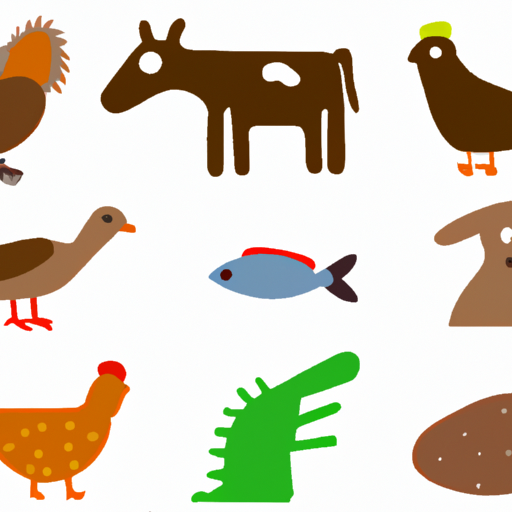 Animals, the fascinating creatures that inhabit our planet, exhibit a wide array of dietary preferences. While some species have evolved to become carnivores, feeding solely on meat, and others have adapted to a herbivorous lifestyle, consuming only plant matter, there exists a unique category of creatures known as omnivores. Omnivores are the ultimate dietary generalists, maintaining a balanced diet by consuming both animal and plant-based foods. In this article, we will explore the vast and diverse world of omnivorous animals, delving into the various species that fall under this category and examining the reasons behind their dietary choices.
Animals, the fascinating creatures that inhabit our planet, exhibit a wide array of dietary preferences. While some species have evolved to become carnivores, feeding solely on meat, and others have adapted to a herbivorous lifestyle, consuming only plant matter, there exists a unique category of creatures known as omnivores. Omnivores are the ultimate dietary generalists, maintaining a balanced diet by consuming both animal and plant-based foods. In this article, we will explore the vast and diverse world of omnivorous animals, delving into the various species that fall under this category and examining the reasons behind their dietary choices.
1. Bears: One of the most well-known examples of omnivorous animals, bears have a highly adaptable diet that varies based on their geographical location and the availability of food sources. While some bear species, such as the polar bear, primarily consume meat, others, like the black bear, are opportunistic omnivores. Black bears have a broad diet, including berries, nuts, insects, fish, small mammals, and even carrion.
2. Pigs: Domesticated pigs and their wild counterparts, such as the wild boar, are omnivorous animals with a diverse range of dietary preferences. Pigs possess a unique digestive system that allows them to efficiently digest both plant and animal matter. While they mainly consume roots, tubers, fruits, and various vegetation, they are also known to scavenge for small animals, insects, and even carrion.
3. Raccoons: Native to North America, raccoons are another prime example of omnivorous animals. These adaptable creatures consume a wide range of foods, including fruits, nuts, insects, small mammals, birds, eggs, and even garbage. Their dexterous paws and ability to manipulate objects make them skilled foragers, enabling them to exploit various food sources in their environment.
4. Crows: Often regarded as highly intelligent creatures, crows are omnivorous birds found across different continents. Their diet consists of an eclectic mix of food items, including insects, small vertebrates, fruits, seeds, nuts, and even carrion. Crows possess remarkable problem-solving abilities, allowing them to access a diverse range of food sources.
5. Humans: As the most dominant species on Earth, humans are also classified as omnivores. Our ability to digest and derive nutrients from both plant and animal-based foods has contributed to our evolutionary success. While cultural and individual dietary choices influence our specific food preferences, humans have the capacity to consume a wide variety of foods, ranging from grains, fruits, and vegetables to meat, fish, and dairy products.
6. Anteaters: Although primarily known for their insatiable appetite for ants and termites, anteaters are classified as omnivorous animals. While their diet predominantly consists of insects, they also consume fruits, small vertebrates, and sometimes even eggs. Their long, sticky tongues and specialized snouts enable them to extract insects from crevices with remarkable precision.
7. Ducks: Many species of ducks are omnivorous, thriving in a variety of habitats across the globe. Their diet encompasses a mix of aquatic vegetation, seeds, insects, small fish, and crustaceans. Their ability to dive and swim enables them to forage for a diverse range of food sources both on land and in water.
8. Foxes: Foxes, found in diverse habitats around the world, are opportunistic omnivores. While they are primarily carnivorous, their diet can vary depending on the availability of prey. Foxes commonly consume small mammals, birds, and reptiles, but they also supplement their diet with fruits, berries, insects, and carrion.
9. Skunks: Skunks, notorious for their ability to emit a noxious odor as a defense mechanism, are omnivorous animals. Their diet consists of a mixture of plant material, such as fruits, berries, and leaves, as well as insects, small mammals, birds, and eggs. Skunks are highly adaptable and can adjust their dietary preferences based on seasonal changes and food availability.
10. Opossums: Found primarily in North and South America, opossums are opportunistic omnivores with a broad diet. They consume fruits, nuts, seeds, insects, small vertebrates, and carrion. Opossums are known for their ability to scavenge and adapt their feeding habits to survive in various environments.
While this article has provided an overview of some omnivorous animals, it is important to note that many other species also fall under this category. The ability to adapt and consume a varied diet has allowed these creatures to thrive in a wide range of habitats. The diverse dietary preferences of omnivores demonstrate the versatility and resilience of these remarkable animals, making them an integral part of our planet’s ecosystem.
